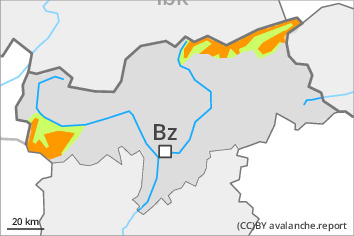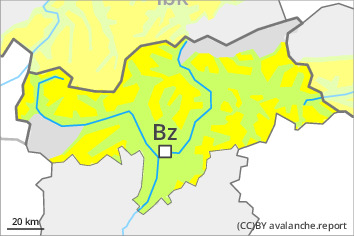
Danger level
 | treeline |
|  |
|  | ||||
|  |
|  |

Wind slabs and weakly bonded old snow represent the main danger.
Weak layers in the old snowpack can be released by individual winter sport participants. The avalanche prone locations are to be found on steep shady slopes above the tree line and on steep sunny slopes above approximately 2400 m. These places are difficult to recognise. Avalanches can be released in deep layers of the snowpack and reach large size in isolated cases. This applies in particular on very steep shady slopes in high Alpine regions. Caution is to be exercised at transitions from a shallow to a deep snowpack.
The fresh and older wind slabs are in some cases prone to triggering. As a consequence of new snow and strong wind the wind slabs will increase in size moderately. These avalanche prone locations are to be found in particular adjacent to ridgelines and in gullies and bowls and on steep shady slopes. Their prevalence will increase with altitude.
On steep grassy slopes and at low and intermediate altitudes more gliding avalanches are possible, but they will be mostly small.
Snowpack
dp.1: deep persistent weak layer
dp.6: cold, loose snow and wind
Some snow will fall on Friday. The wind will be strong in some regions.
The snowpack will be subject to considerable local variations. Faceted weak layers exist in the bottom section of the snowpack at elevated altitudes. Faceted weak layers exist in the top section of the snowpack especially on shady slopes.
Fresh wind slabs are lying on soft layers in particular on shady slopes at elevated altitudes.
Tendency
The avalanche danger will persist. The wind will be strong.




